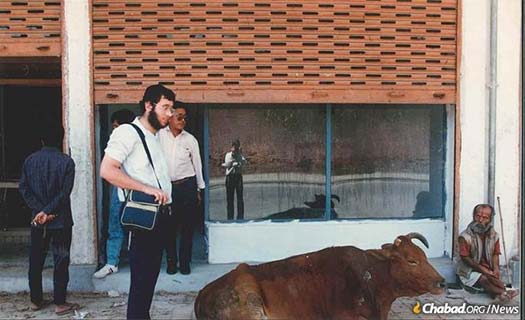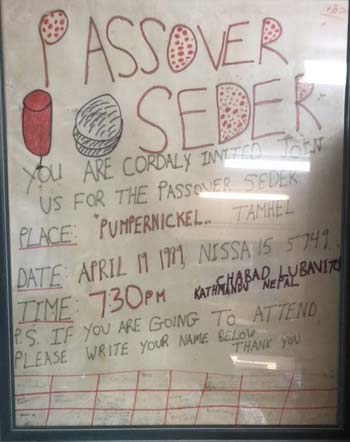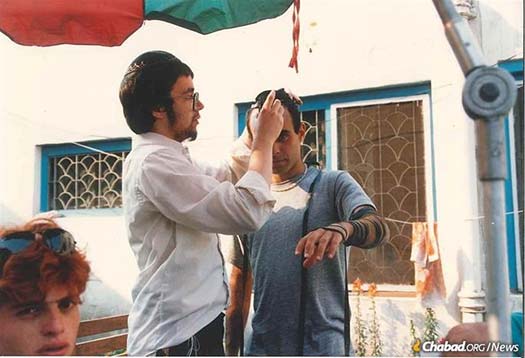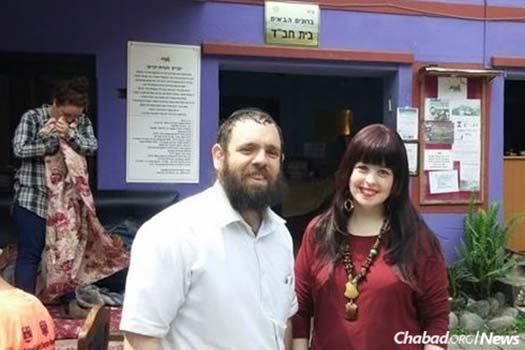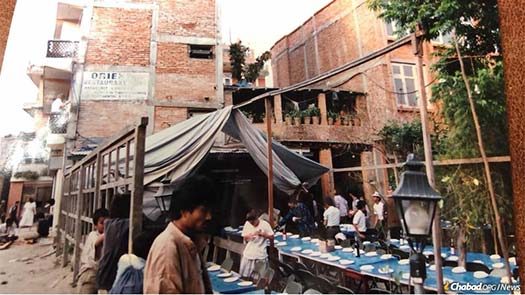
30 Years in Kathmandu: How World’s Largest Seder Transformed Jewish Life in Asia
by Phreddy Wischusen – Chabad.org
When 20-year-old rabbinical students Mendel Kastel and Mendel Lipskier arrived in Kathmandu, Nepal, on very short notice in April 1989, they knew they had their work cut out for them. But they were ready.
Preparing a large, communal Passover Seder is logistically challenging anywhere, but it’s especially daunting in Kathmandu, Nepal, where a mix of backpackers and professionals from all over Asia and the world have converged every year for the past 30 years for “The World’s Largest Seder.”
The two students, who were attending yeshivah in Australia, had to ensure that all spaces were thoroughly cleaned; utensils and stoves kashered; chametz (grain that has risen) sold or otherwise disposed of; food cooked; matzah and wine provided, and that every last Jew in the area was invited. Doing all that without precedent thousands of miles from the nearest Jewish community in a pre-Internet world, seemed almost impossible.
Only a few weeks earlier, Israel’s Ambassador to Nepal, Shmuel Moyal, had hung up a sign-in sheet at a popular restaurant announcing a Seder at Israel’s embassy, expecting that 30 or 40 Israelis would attend. But when nearly 90 people signed up just three weeks before Passover, he turned to the Rebbe—Rabbi Menachem M. Schneerson, of righteous memory—for help.
“I sent a telegram to Rabbi Schneerson, who I knew from when I was a consul in New York,” Moyal told Chabad.org in 2011. The Rebbe sent word to the ambassador not to worry, that he would send rabbinical students to help.
On arriving in Kathmandu, Kastel, a native of Brooklyn, N.Y., recalls seeing “cows walking around the streets, and all the water for drinking and cooking had to be boiled.” Getting the word out was even harder. Not only was there no Internet, “but even phone calls had to be scheduled in advance,” Kastel tells Chabad.org. Wanting to reach as many Jews as possible, the rabbinical students and some backpackers began making their own handwritten signs and hanging them up all over the city.
Before coming to Nepal, they hoped that they might be able to add to the 90 guests signed up by the Israeli embassy, and that 150 people might attend the Seder. But word spread quickly, and as the list of people signing up for the Seder on the bottom of big cardboard posters placed around Kathmandu began to overflow, it was apparent that many, many more wanted to come. Before long, it seemed that Jews from all over Asia, tourists and businesspeople alike, were heading to Kathmandu for the event.
First, they had to find a location for the meal. As there was no space large enough to hold a crowd of more than 100 strong, Kastel and Lipskier found a local establishment whose owner allowed them to host the Seder in its backyard. They bought all of the vegetables at the local market, buying almost everything there, and then set about kashering the kitchen and building a brick oven on which to cook the food.
“Meanwhile, the expected number of guests kept growing,” recalls Kastel, “and the matzah, kosher wine and gefilte fish making its way from Israel was embargoed” because of a row between India and Nepal. There was another problem: They had no tables.
But the young rabbis continued to prevail.
The Israeli embassy helped the food shipment get through, and a tractor traveled two hours over mountain passes with a load of card tables, which were too small for Seder tables. A builder constructing a hotel loaned them all the doors to be laid atop the card tables and crates to make the tables larger.
On the Seder night, 500 Jews from far and wide—Israel, the United Kingdom, the United States, France, South America and beyond—gathered in a backyard in Nepal to celebrate a 3,300-year-old ritual in the shadow of the world’s tallest mountains, under the light of a full moon, surrounded by hundreds of Nepalese lining the top of the walls wanting to see what the singing and cheering was all about.
High-Altitude Seders Through the 1990s
The next year, Rabbi Asi Spiegel, 21 at the time, and his friends—Rabbi Dovid Bisk and Rabbi Chaim Baruch Alevsky—conducted the Kathmandu Seder under the auspices of Merkos L’Inyonei Chinuch, the educational arm of Chabad-Lubavitch, which under the direction of Rabbi Moshe Kotlarsky, its vice chairman, continues to send young “Roving Rabbis” around the world. (This year, some 700 Chabad rabbinical students will help to host hundreds of Seders in dozens of countries around the world.)
Spiegel and Bisk arranged to hold the Seder at the Israeli Embassy. Despite having the embassy staff to help, there were new challenges. The country was in the midst of a civil war, and a few days before Passover, 50 protesters marching on the palace were killed.
“The embassy was considering canceling the Seder,” recalls Spiegel, adding that the Rebbe gave them a blessing and urged them to push forward. The morning before the Seder, Nepal’s King Birendra agreed to some of the protesters’ requests, lifting the ban on political parties in Nepal, allowing for the first possibility of democratic reform in the mountain kingdom and clearing the way for the Seder to go on.
More than 700 people came for the Seder. Spiegel remembers the feeling of joy and connection everyone experienced. “I grew up in Israel,” he says. “Meetings between yeshivah students and ‘secular’ Israelis in Tel Aviv weren’t always that friendly. But in Nepal, suddenly everyone was super friendly. The backpackers were thrilled to meet us. Right away, all the issues of Israel just disappeared.”
A Profound Impact on Young Backpackers
Those early Seders proved to be transformative in the lives of many of the young backpackers who took part. “[The Seder] was a real eye-opener for me,” Irit Goren told Lubavitch News Service in 1991. The Tel Aviv native had come to Nepal to study Eastern religions. “This is the first time Judaism had any meaning for me,” she said. “I never knew that Judaism was so spiritual.”
Goren’s sentiments were shared by thousands who attended the early Seders, and news spread in Israel by word-of-mouth and through stories in Israel’s news media. Spiegel and Bisk went on to host six more Seders over the next eight years. Eitan Levi, second-in-command in the Israeli Embassy in 1995, a year that Spiegel couldn’t make it, took it upon himself to keep the tradition going and make the Seder happen.
“We knew that Chabad has places all over the world. If we want the Seder to be right and kosher, Chabad could help us, like sending supplies from Israel for the expected 1,200 people. They ended up sending us a huge package via diplomatic mail: wine, matzah and other kosher products, in addition to a few young emissaries,” he said.
A huge tent was erected on the embassy grounds with the help of the Nepalese Army and police. Then he and his wife, Yudit, organized 50 backpackers to help prepare the feast. “Even my mother-in-law, my sister-in-law and my brother-in-law were there cleaning vegetables.”
During the Seder, Mrs. Levi recalls, “My daughter was about 2-and-a-half years old; She stood on the table and recited the Mah Nishtanah (Four Questions), and every time she finished singing a part, 1,200 people would sing in response. It was something truly awesome and beauRabbi Chezki and Chani Lifshitz, co-directors of Chabad of Nepal
Rabbi Chezki and Chani Lifshitz, co-directors of Chabad of Nepaltiful.”
A Permanent Presence
Rabbi Chezki and Chani Lifshitz have co-directed Nepal’s Chabad center and run the Seder since 2000. For this year’s Seder, they’ve ordered more than 1,500 pounds of matzah and 1,000 bottles of wine. They, too, face challenges every year. Shipping to Nepal is notoriously difficult: “One time the truck fell down in India, and a helicopter had to bring the stuff,” says Lifshitz. “Another time the shipment arrived in Malaysia by mistake and didn’t make it to Nepal until one week after Pesach.” So a month ago, the Lifshitzes started making their own wine—just in case. They have already produced more than 250 gallons.
Throughout the year, the Lifshitzes give Torah-study classes; hold daily, Shabbat and holiday services; run two kosher restaurants; and serve the many material and spiritual needs of Jewish trekkers year-round, down to the detail of providing them with satellite phones so they can be in contact in case of an emergency. The couple has been an important presence in the country during and after devastating earthquakes, and responding to emergencies and tragedies involving hikers and climbers.
And the Seders don’t take place just in the Nepalese capital. This year, teams of “Roving Rabbis” will assist the Lifshitzes by conducting Seders at several locations around the country.
Worldwide Network for Jewish Backpackers
Extending far beyond Nepal, the annual Seder in Kathmandu planted the seeds for what has become a growing network of permanent Chabad centers throughout Southeast Asia, providing Jewish backpackers with a Jewish home away from home year-round. Today, that network stretches as far as South America and Australia, with dozens of centers serving as anchors for Jewish life to the many thousands of travelers they reach each year.
This Passover, in a kind of reunion, Kastel is bringing his whole family—his wife, Tzippi, their seven children and two grandchildren—to what will be the 30th Chabad Seder in Kathmandu. And no matter what happens, he says, it will be a joyful occasion for all.
Despite the challenges, the emissaries who have hosted Seders in Kathmandu for the past 30 years cite the Rebbe’s vision of love for their fellow Jews as the inspiration for all the hard work they did to bring Passover to Jews so far from home.
As thousands of Israelis, strapped into their backpacks, leave Ben-Gurion Airport in Tel Aviv for Asia and South America to “find themselves” for a year or two, thousands of others are returning home inspired, having found their Jewish selves in a neutral ground devoid of politics where they are embraced with simple love as a Jewish brother or sister.
In Nepal, says Spiegel, “it was the first time I understood how much the Rebbe wanted us to go to work, to be there for other Jews, even somewhere so far away. If we set our minds to that, nothing could stop us.”
